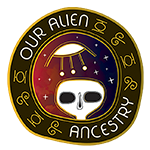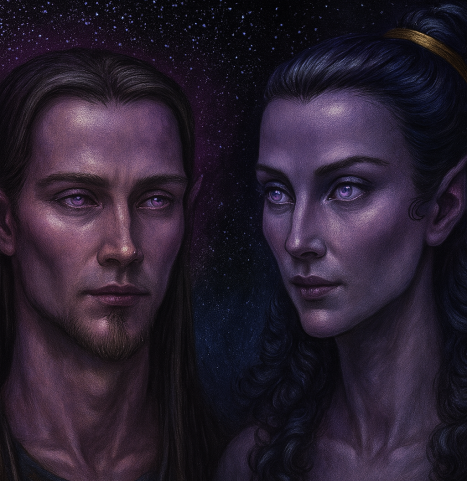
There’s usually an explanation for everything we see. When we encounter something mysterious that piques our interest, we begin asking the questions how and why, and we search for answers. Sometimes we don’t receive a full explanation of how this mysterious thing appeared—or why—even with all the available physical evidence surrounding it.
What we do then is try to paint a picture to provide the missing answers, just so we can rest easier at night.
We are a curious species, but when something comes along that is too challenging for us to solve, we shelve it or ignore it in favor of the lovely picture we’ve created in our minds. That’s how the “wise, wise ape” conducts life.
I’m luckier than most who seek answers. I’ve been in contact with extra-terrestrials for decades. I am a Homo novis (new human), also known as a Starseed. I’ve had the privilege of meeting so many colorful and quirky people across the stars and seeing life in thousands of unique forms through my travels.
Through telepathic communication with my contacts, I usually receive answers to my questions—if they feel like picking up the call! However, I’m not the only one who’s had contact with them—not now, and certainly not in the distant past.
Humans have always had contact with E.T.s, whether through telepathic, astral, or physical means. You read that correctly: physical contact.
About half a million years ago, a new type of hominid arrived on this planet. Its development was a combination of natural evolution and selected alterations from an external, intelligent source.
Many beings came from distant places to visit this world. Most left. Some stayed—and died. The ones who stayed are the most curious case: Did they remain in secluded areas of the world, too far for terrestrial natives to reach? Or did they mingle and combine? Both are true—for different species and at different times.
What is often overlooked when discussing extra-terrestrial visitations is that these beings come from vastly different realms and possess unique physiologies. We don’t share the same requirements for survival.
What I’ve learned is that some species have developed to live in total darkness, arid desert plains, humid jungles, frigid mountain peaks, or steep canyons with few flat surfaces. Though we may share some physical traits, each has slightly different adaptations suited to their home climates.
When E.T.s visit Earth, they tend to stay in areas that resemble the environments on their homeworlds. They certainly have equipment like environmental suits and domes to help them survive here—but it’s not required if the proper terrain already exists on the visiting planet.
Despite these needs, some E.T.s have chosen to introduce themselves to humans and participate in our culture. As one might imagine, they were probably seen as angels or demons, gods or spirits by early humans.
Perhaps after enough interaction, those humans began to realize they were just brothers and sisters from other worlds—beings who could love, laugh, cry, envy, and become enraged. At some point, it was understood: we were the same. Through that understanding, both groups became one.
Tens of thousands of years later, I attended one of Steven and Evan Strong’s conferences and had the opportunity to see some of the skeletal remains they had uncovered during their careers.
One of the skulls caught my eye. It was a casing from the original (a bad idea to travel with actual human remains).
It had two eye sockets significantly larger than those of Homo sapiens sapiens, a nasal bone that protruded nearly 90 degrees from the head—unlike the natural slope found in humans—and most strikingly, no forehead.
That’s not to say this being didn’t have a brain. In fact, its cranial capacity was greater than a human’s.
Imagine the brow being the highest point of the body before the rest of the skull sloped sharply down, resting near the upper back.
There were still teeth lodged in the upper jaw, though the first two had been removed—supposedly during a human ceremony.
One could assume this was simply a deformed human who happened to survive to adulthood in the harsh wilds of ancient Australia. But I doubt a child born without skull sutures (the ribbed plates that expand as we grow) would have been physically possible to deliver from a human womb.
My skin tingled, and I trembled when I saw it—a once-living being that walked this Earth, and yet had come from elsewhere.
This was truth.
I had never seen a being like this before, nor heard of such lifeforms in my travels. I consulted my contacts, seeking any information about who or what they were.
After a short wait, I received an answer. One of my primary contacts, Mezreth, responded (paraphrasing the incoming telepathic message):
“They used to come here—to Earth. Not anymore. They’re done with it. You won’t see them among us either—they live on their own world now, living like you used to live. Both of our races (referring to Mezreth’s people) grew up together on the homeworld.
While we walked the lands and swam in the seas, they dwelled on cliffs and high mountains. They slept through the sun and woke in darkness.
We were friends. We traveled the stars and saw many things together. But after a long, long while, they grew tired of it. They had their reasons—and we didn’t press.
Many here (referring to younger E.T. peoples) wouldn’t have seen them in person. But occasionally, they touch our minds—to see what we’re doing. Sometimes, they just don’t want us to forget them.”
I asked what they were called.
“Their specific name isn’t important. You would know them as ‘Pleiadians.’ From your perspective, they came from that star cluster—but so did many others who are also called by that name.”
Then, I saw an image of them.
They were tall, lanky, with nearly translucent blue skin—no hair or fur. I remember their steely, silver eyes: like two round mirrors glaring back in my mind.
Their bodies hunched in unnatural positions. Two long arms dragged beside narrow feet with three thick, finger-like toes. Despite their slimness, they were incredibly muscular—hands that looked capable of crushing rock.
I don’t remember if they wore garments. Perhaps they did, but for the sake of showing how their bodies looked, that detail wasn’t included in the vision.
Mezreth’s kind did not resemble them. His people stood upright, with heads shaped like human heads—only their foreheads were taller to fit extra brain matter.
However, Mezreth’s species has evolved to the point that they no longer possess physical bodies as we understand them.
The same can’t be said for the other race. Mezreth didn’t mention them having become energy-based. Though, for my sanity, he appears wearing clothes when visiting me.
I tried to learn more—about their culture, biology, history, and why they stopped traveling the stars. The clearest impression I got from Mezreth was simply dissatisfaction.
Why they were dissatisfied, or who that feeling was directed toward, remains unclear.
Still, I couldn’t shake the sense of love and admiration I felt from the skull. Yes, it was only a plaster casing—but some reddish dust remained from the original.
There were no distinct thoughts or memories in that impression, only primal emotions that lingered in the dust.
This being had been loved. Admired.
Whoever buried them cared enough to lay their body to rest—a sign of deep respect. It also shows that early humans were capable of putting aside their fear or distrust of someone who appeared so different.
They looked beyond the skin and saw a heart, a mind, and a spirit—a being who wished to share life and death with them.
Early humanity understood that beauty lay in the soul.
They saw that this being, though from a distant world and shaped by alien forces, was still a child of creation.
If they could do that—why can’t we?
Mezreth has taught me a lot—not just about E.T.s and the stars, but about humanity. He sees dimensions of our species that are often overlooked, buried under the horror we inflict on one another and on the truth.
I once asked him, “How can you be so sure we can change? Why do we deserve compassion from your kind, when we don’t even give it to ourselves—let alone return it to you?”
He said:
“There’s a seed that stopped sprouting in all of you. With watering and tending, it will flourish into something magnificent—something that will reach beyond the stars.”
~
My experiences don’t end with Mezreth, his kin, or even my current contact.
In times long past, I was born, lived, and died on distant worlds. I remember some of those lives—memories filled with both wonder and horror.
Over several years, I’ve recorded all the memories I could draw from my soul—three lifetimes’ worth—into a book.



